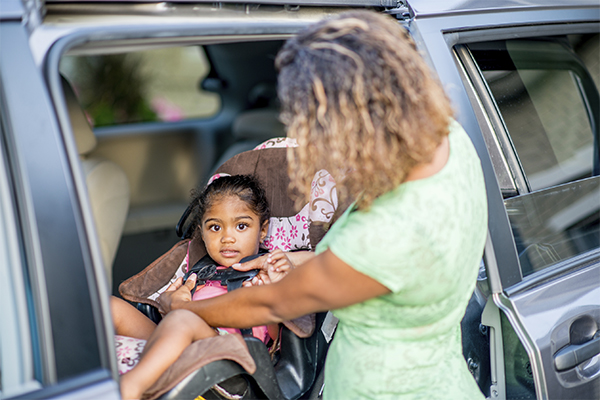It doesn’t matter if you are going around the block or across the country, what matters is that your children are properly buckled up. There are, however, some simple tips you can follow to make the trip easier and more pleasant for all. I will address proper seat selection along with use and installation tips, but before I do, let’s talk about getting ready for a road trip.
Before you leave the house, ask yourself a few questions:
- How long is this trip
Children need to get out of the car and stretch as well as burn off energy. Plan to stop at least every two hours (more frequently for infants and special needs children). - How will I keep the children entertained during the trip
While children love music, don’t depend on the radio to keep them entertained. I suggest packing a surprise bag for each leg of the trip (a four-hour trip needs two surprise bags). These are nothing more than putting some age-appropriate, vehicle-friendly (soft – no metal) toys into a bag children are not allowed to look into until you are on the road. - How to dress for the car ride
Children should not be placed in child safety seats with heavy/bulky clothing. It can make the harnesses act as if they’re loose during a crash. In addition, a coat can’t be removed once the vehicle warms up without taking off the child safety seat harness. Place children in their safety seat, buckle them up, and then they can put their coat on backwards or use a blanket until the car warms up.
When it’s time to get in the car, be sure children are properly restrained.
- Rear Facing
Children should remain rear facing as long as possible. This position in the vehicle provides a significantly greater amount of protection to the head, neck, and spine. Many seats available on the market will allow children to ride rear facing until at least 40 pounds. Shoulder straps should be at or below shoulder level, and the chest clip should be at armpit level (do not confuse nipple line with armpit level – draw an imaginary line between the armpits, and this is where the chest clip should go). You should not be able to pinch any slack in the harnesses at the shoulder level. - Forward Facing
When children have outgrown their rear-facing seat, they should continue to ride in a fully harnessed seat. Many seats will allow children to remain in a harnessed seat until 65 pounds or more. Don’t be in a hurry to advance. The harness should be at or above the shoulders now, but the chest clip and pinch test still apply. - Booster seats
When children outgrow the forward-facing seat by weight or height, move to a booster seat. Continue to use the booster seat until they are at least 4 feet 9 inches tall. Younger children will benefit from a high-back booster.
For more information, contact Safe Kids Greater Augusta or call 706-721-7606.




